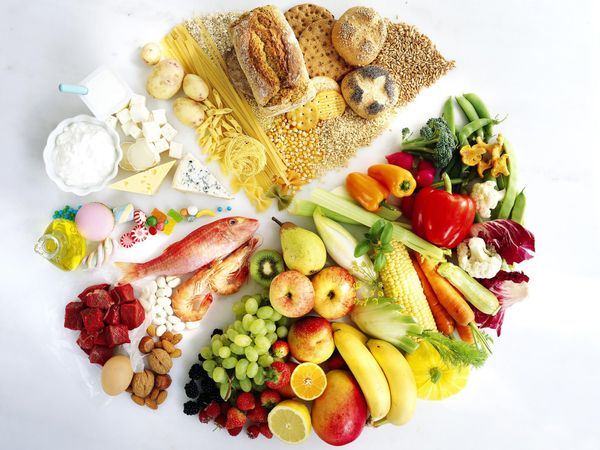
People look at food labels for a variety of reasons. But whatever the reason, many consumers would like to know how to use this information more effectively and easily. The following label-reading skills are intended to make it easier for you to use the Nutrition Facts labels to make quick, informed food decisions to help you choose a healthy diet.
Overview
The information in the main or top section (see #1-4) of the sample nutrition label (below) can vary with each food and beverage product; it contains product-specific information (serving size, calories, and nutrient information). The bottom section contains a footnote that explains the % Daily Value and gives the number of calories used for general nutrition advice.
In the following Nutrition Facts label we have colored certain sections to help you focus on those areas that will be explained in detail. Note that these colored sections are not on the actual food labels of products you purchase.
Sample Label for Frozen Lasagna

1. Serving Information
(#1 on sample label)
When looking at the Nutrition Facts label, first take a look at the number of servings in the package (servings per container) and the serving size. Serving sizes are standardized to make it easier to compare similar foods; they are provided in familiar units, such as cups or pieces, followed by the metric amount, e.g., the number of grams (g). The serving size reflects the amount that people typically eat or drink. It is not a recommendation of how much you should eat or drink.
It’s important to realize that all the nutrient amounts shown on the label, including the number of calories, refer to the size of the serving. Pay attention to the serving size, especially how many servings there are in the food package. For example, you might ask yourself if you are consuming ½ serving, 1 serving, or more. In the sample label, one serving of lasagna equals 1 cup. If you ate two cups, you would be consuming two servings. That is two times the calories and nutrients shown in the sample label, so you would need to double the nutrient and calorie amounts, as well as the %DVs, to see what you are getting in two servings.
2. Calories
(#2 on sample label)
Calories provide a measure of how much energy you get from a serving of this food. In the example, there are 280 calories in one serving of lasagna. What if you ate the entire package? Then, you would consume 4 servings, or 1,120 calories.
To achieve or maintain a healthy body weight, balance the number of calories you eat and drink with the number of calories your body uses. 2,000 calories a day is used as a general guide for nutrition advice. Your calorie needs may be higher or lower and vary depending on your age, sex, height, weight, and physical activity level. Learn your estimated calorie needs.
3. Nutrients
(#3 on sample label)
Look at section 3 in the sample label. It shows you some key nutrients that impact your health. You can use the label to support your personal dietary needs – look for foods that contain more of the nutrients you want to get more of and less of the nutrients you may want to limit.
- Nutrients to get less of: Saturated Fat, Sodium, and Added Sugars.
Saturated fat, sodium, and added sugars are nutrients listed on the label that may be associated with adverse health effects – and Americans generally consume too much of them, according to the recommended limits for these nutrients. They are identified as nutrients to get less of. Eating too much saturated fat and sodium, for example, is associated with an increased risk of developing some health conditions, like cardiovascular disease and high blood pressure. Consuming too much added sugars can make it hard to meet important nutrient needs while staying within calorie limits.
What are Added Sugars and How are they Different from Total Sugars?
Total Sugars on the Nutrition Facts label includes sugars naturally present in many nutritious foods and beverages, such as sugar in milk and fruit as well as any added sugars that may be present in the product. No Daily Reference Value has been established for total sugars because no recommendation has been made for the total amount to eat in a day.
Added Sugars on the Nutrition Facts label include sugars that are added during the processing of foods (such as sucrose or dextrose), foods packaged as sweeteners (such as table sugar), sugars from syrups and honey, and sugars from concentrated fruit or vegetable juices. Diets high in calories from added sugars can make it difficult to meet daily recommended levels of important nutrients while staying within calorie limits.
Note: Having the word “includes” before Added Sugars on the label indicates that Added Sugars are included in the number of grams of Total Sugars in the product.
For example, a container of yogurt with added sweeteners, might list:
This means that the product has 7 grams of Added Sugars and 8 grams of naturally occurring sugars – for a total of 15 grams of sugar.
- Nutrients to get more of: Dietary Fiber, Vitamin D, Calcium, Iron, and Potassium.
Dietary fiber, vitamin D, calcium, iron ad potassium are nutrients on the label that Americans generally do not get the recommended amount of. They are identified as nutrients to get more of. Eating a diet high in dietary fiber can increase the frequency of bowel movements, lower blood glucose and cholesterol levels, and reduce calorie intake. Diets higher in vitamin D, calcium, iron, and potassium can reduce the risk of developing osteoporosis, anemia, and high blood pressure.
4. The Percent Daily Value (%DV)
(#4 on sample label)
The % Daily Value (%DV) is the percentage of the Daily Value for each nutrient in a serving of the food. The Daily Values are reference amounts (expressed in grams, milligrams, or micrograms) of nutrients to consume or not to exceed each day.
The %DV shows how much a nutrient in a serving of a food contributes to a total daily diet.
The %DV helps you determine if a serving of food is high or low in a nutrient.
Do you need to know how to calculate percentages to use the %DV? No, because the label (the %DV) does the math for you! It helps you interpret the nutrient numbers (grams, milligrams, or micrograms) by putting them all on the same scale for the day (0-100%DV). The %DV column doesn’t add up vertically to 100%. Instead, the %DV is the percentage of the Daily Value for each nutrient in a serving of the food. It can tell you if a serving of food is high or low in a nutrient and whether a serving of the food contributes a lot, or a little, to your daily diet for each nutrient.
General Guide to %DV
- 5% DV or less of a nutrient per serving is considered low
- 20% DV or more of a nutrient per serving is considered high
More often, choose foods that are:
- Higher in %DV for Dietary Fiber, Vitamin D, Calcium, Iron, and Potassium
- Lower in %DV for Saturated Fat, Sodium, and Added Sugars
Source : The FDA
More on Fitness & Nutrition











Leave A Comment
You must be logged in to post a comment.